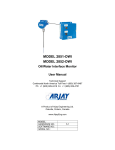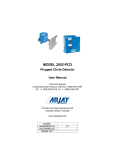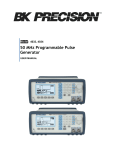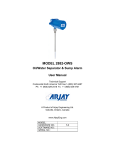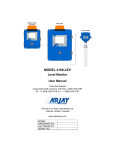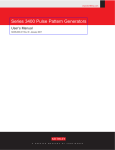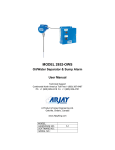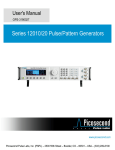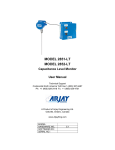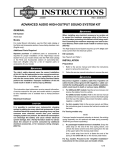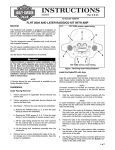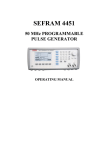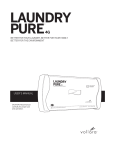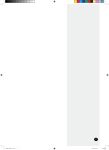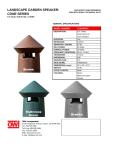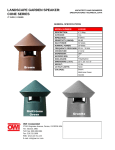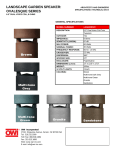Download Manual
Transcript
MODEL 2880-OWI / 2880W-OWI MODEL 2881-OWI / 2881W-OWI MODEL 2882-OWI / 2882W-OWI Oil/Water Interface Transmitter User Manual Technical Support Continental North America Toll Free 1-(800) 387-9487 Ph: +1 (905) 829-2418 Fx: +1 (905) 829-4701 A Product of Arjay Engineering Ltd. Oakville, Ontario, Canada www.ArjayEng.com MODEL: HARDWARE NO.: SOFTWARE NO.: SERIAL NO.: 5.1 2880-OWI / 2881-OWI / 2882-OWI Oil/Water Interface Transmitter ENGINEERING Reliable monitoring of oil/water interface and emulsions Over 40 years of capacitance experience stands behind the 2880-OWI transmitter. The sensing probe continuously monitors the capacitance of the inserted probe. As the interface or emulsion layer (rag layer) crosses over the probe, a proportional 4-20 mA output is provided. Typical applications include oil water separators, oil/water knock-out tanks, treater trains and decanting tanks. power input 4-20 mA / RS-485 Modbus • capacitance technology does not foul or require cleaning • no moving parts • remote monitor mounts safely away from the process The 2880-OWI sensing probe monitors the capacitance field around the probe. A calibration is performed against the an oil condition and a water condition. The active portion of the probe is fully submerged into the liquid and sized to your targeted range of interest. As the oil/water interface or emulsion crosses or envelopes the probe, the capacitance change is tracked and an output of 4-20 mA is provided. explosion proof probe head 3/4” npt 316SS process connection on standard probes (flanges optional) Inactive probe Sheath (length to order) Teflon coated probe (length to order) 2880-OWI Features and Benefits Technical Specifications - Probe • no moving parts • electronics is integral to the probe • high corrosion resistant Teflon and stainless steel wetted parts • capacitance technology responds to all oil types • HF capacitance technology does not require routine cleaning • easy calibration and control set-up Process Temp. Pressure Technical Specifications - Electronics Operating Temp. Resolution Accuracy Power Input Communication Control Interface 2880-OWI 2881-OWI 2882-OWI Optional CRN Wetted Parts Probe materials are eligible for NACE MR-0175 Compliance Hazardous Location Use Available Component Certifications may be suitable to your application. Consult Arjay for assistance. -20˚C to +55˚C .007% (.07 pF at 1,000 pF) .04% of full scale pF 12 vdc or 24 vdc, 0.1 amp max. 100-240 vac +/- 10% RS-485 Modbus 0/4-20 mA non-isolated output 0/4-20 mA isolated output 0/4-20 mA non-isolated output and 2 x 10amp@240 vac, SPDT, dry relays -60°C to +260°C (Teflon probe) 103 bar/10342 kPA/1500psi at stable temperature ABSA-CRN #OF07450.2 316SS and Teflon 2880 Electrical Safety UL, CSA, or IEC 61010 Housing UL / FM / CSA Class 1, Group B,C,D; Class II, Group E,F,G Probe CSA Class 1, Group C,D The electronics for this model can also be mounted remote from the probe. Refer to the Model 2852-OWI. The probe becomes Intrinsically Safe when ordered with an IS Barrier installed in 2852-OWI control panel: CSA Div 1, Class 1, Groups A,B,C,D Viewing window of % Level LCD Alarm and Status LCD display of alarm status and menus RS-485 Modbus user interface Optional Relays 0/4-20 mA output Power input All calibration and power wiring is done at the main control unit. This is mounted directly onto the probe. ENGINEERING Arjay Engineering Ltd. http://www.arjayeng.com 2851 Brighton Road Oakville, Ontario telephone: ++1 905-829-2418 Canada L6H 6C9 N. America toll free: 1-800-387-9487 fax: ++1 905-829-4701 2880-OWI-12a Model: 2880-OWI, 2881-OWI, 2882-OWI User Manual Rev: 2.0 TABLE OF CONTENTS 1.0 2.0 3.0 4.0 5.0 6.0 7.0 INSTRUMENT OVERVIEW ............................................................................................3 1.1 Features .............................................................................................................3 1.2 Model Number Table..........................................................................................3 1.3 Specifications .....................................................................................................4 INSTALLATION...............................................................................................................6 2.1 Probes ................................................................................................................6 2.2 Probe installation................................................................................................6 2.3 Electrical Installation ..........................................................................................9 2.3.1 Permanent Power Connection (AC Powered Models only) ................9 2.3.2 Input / Output Terminal Specification ..................................................11 2.4 Glossary of Symbols ..........................................................................................12 STARTUP AND CALIBRATION ......................................................................................13 3.1 Startup ................................................................................................................13 3.2 Menu Flow Chart Background Information ........................................................13 3.2.1 Menu Description.................................................................................13 3.2.2 Menu Description.................................................................................13 3.2.3 Data Entry............................................................................................14 3.3 2880 Transmitter Calibration..............................................................................14 3.3.1 Auto Calibration ...................................................................................14 3.3.2 Manual Calibration...............................................................................15 SETUP AND NETWORK ................................................................................................16 4.1 2880 Transmitter Setup .....................................................................................16 4.2 2882 Transmitter Relay Setup (2882 Option only) ............................................17 4.3 2880 Transmitter Network ..................................................................................18 4.3.1 Modbus Configuration .........................................................................18 4.3.2 2800 Series Modbus Register Mapping ..............................................19 MAINTENANCE ..............................................................................................................20 TROUBLESHOOTING ....................................................................................................21 FLOW CHARTS ..............................................................................................................22 TABLE OF FIGURES Figure 1 – Probe Installation Figure 2 – Typical Installation Overview 1 Figure 3 – Typical Installation Overview 2 Figure 4 – Electrical Installation Overview 7 7 8 10 2 Model: 2880-OWI, 2881-OWI, 2882-OWI 1.0 User Manual Rev: 2.0 INSTRUMENT OVERVIEW The 2880-OWI sensing probe monitors the capacitance field around the active probe. As the oil/water interface level moves up and down the probe, the capacitance change in picofards (pF) is monitored by the Arjay processor and translated into a 4-20 mA proportional output and Modbus RS-485 communication. After the probe is installed and the vessel is filled with liquid, a calibration will be required by entering the % value of two different oil/water interface levels. The oil/water interface level must be physically changed in the vessel to allow the 2880-OWI to match your entered % interface level against the pF reading of the probe. 1.1 Features 1.2 Microprocessor based capacitance level transmitter 4-20mA proportional output with optional signal isolator 4-20 mA can be: Direct acting 4 to 20 mA = 0% water (100%oil) to 100% water (0% oil) or Indirect acting 4 to 20 mA = 0% oil (100% water) to 100% oil (0% water) Modbus protocol via RS-485 for access by Arjay handheld, Central Access Panel or compatible system Local 2 point Auto or Manual calibration or remote calibration via network User specified custom features may be added by contacting Arjay Engineering Ltd. Model Number Table MODEL DESCRIPTION 2880-OWI PROBE MOUNTED 4-20mA (NON-ISOLATED) 2880W-OWI PROBE MOUNTED 4-20mA (NON-ISOLATED) - WINDOW MOUNT 2881-OWI PROBE MOUNTED 4-20mA (ISOLATED) 2881W-OWI PROBE MOUNTED 4-20mA (ISOLATED) - WINDOW MOUNT 2882-OWI PROBE MOUNTED 4-20mA (NON-ISOLATED) C/W RELAYS 2882W-OWI PROBE MOUNTED 4-20mA (NON-ISOLATED) C/W RELAYS - WINDOW MOUNT 3 Model: 2880-OWI, 2881-OWI, 2882-OWI 1.3 User Manual Rev: 2.0 Specifications Power Input: 12 VDC +15% /-10% or 24 VDC +15% /-10%, 250mA maximum 100VAC – 240VAC +/- 10%, 50/60 Hz, 150mA maximum Note: DC input models must be supplied by Limited Energy power source. Limited Energy means compliance with one of the following requirements: - Connections to mains supply Class 2 circuit according to Canadian Electrical Code, Part, I, C22.1; Class 2 circuit according to National Electrical Code, NFPA-70; Limited Power Supply (LPS) according to IEC 60950-1; Limited-energy circuit according to IEC 61010-1. Permanent (for AC/DC model) User Interface: Display & Keypad Two line LCD with Alarm status display, select menu or enter values by keypad (display is internal to housing and used for set-up and diagnostics only) Communication Interface: Modbus (RS485) Analog /Relay Outputs: mA Signal Output 4-20 mA DC, 900 Ohms max OR 450 Ohms max (12VDC Power) (2881: Isolated)** ** Optional (Note: If Isolation is ordered then relays are not available) Relay Output 2 SPDT relay, dry, N.O. Contact 5A @ 250 VAC (Resistive) and N.C. Contact 3A @ 250VAC (Resistive), selectable failsafe or non-failsafe, selectable high or low acting alarm, programmable time delay: 0 – 600 seconds Instrument Performance: Measuring Range 0 - 1000 pF (most applications are 100pF to 1000pF) Accuracy 0.2% Resolution 0.05% of setpoint via network display 0.002% of Full Scale capacitance via network display Calibration Linear 2 point Auto calibration and Manual calibration Environmental: Operating conditions Continuous Operating Temperature -20 °C to +55 °C controller -60 °C to + 260 °C probe Relative humidity 0 to 95% (non-condensing) Altitude ≤2000 m Installation Category II Pollution Degree 2 Equipment mobility Fixed 4 Model: 2880-OWI, 2881-OWI, 2882-OWI User Manual Mechanical Specification: Refer to Dimensional Drawing Approval Standards: Rev: 2.0 UL / IEC 61010-1, 2nd Edition, 2005-07-22 (Electrical Equipment for Measurement, Control, and Laboratory Use; Part 1: General Requirements) UL file number: E343390 CAN/CSA-22.2 No. 61010-1, 2nd Edition, 2004-07, (Electrical Equipment for Measurement, Control, and Laboratory Use; Part 1: General Requirements) CE: UL / IEC 61010-1; IEC / EN 61000-4; ISO 9001:2008 5 Model: 2880-OWI, 2881-OWI, 2882-OWI 2.0 User Manual Rev: 2.0 INSTALLATION NOTE: If any damage to the instrument is found, please notify an Arjay Engineering representative as soon as possible prior to installation. 2.1 Probes The 2880-OWI Series Level Transmitter consists of the transmitter enclosure fitted with a capacitance probe. The probe length is customer specified for the tank and range of interface to be measured. Teflon coated probes are most typical. Most probes will include an inactive stainless steel sheath on the upper portion of the probe. This is to blind the probe from the affects of entrance nozzles, vapours, and changes in the upper liquid/gas phase. The active portion of the 2880-OWI probe must only see oil, water, or the interface combination of oil and water. If the overall liquid level lowers to expose the active portion of the probe to vapour, the output will indicate a decreasing interface level (less water, more oil). It is recommended to use a flange, union, or retraction device for easy retraction of the probe from the tank while maintaining the wiring connections. This can aide in calibration and routine testing. 2.2 Probe installation The factory process connection is a 3/4" MNPT 316SS fitting (standard probes) or 1" MNPT (heavy duty probes). Flanges, concentric shields and retraction devices are available as options. The entrance configuration may vary depending on the application requirements. WHEN USING THE PROBE FITTING, USE A WRENCH ON THE LOWER FITTING ONLY. The probe fittings are compression type with Teflon ferrules assembled by applying torque between the two hex sections. The fittings are sealed at the factory to provide a compression seal capable of withstanding high pressures. Once opened they cannot be reassembled without new ferrules. The probe orientation can be vertical or angled The length of the exposed active probe needs to extend the full vertical interface change level (refer to Drawing 2.1 an d 2.2). Concentric shields can be considered for improved linearity. Shields should only be used on clean separations where clogging from a rag (emulsion) layer is not a concern. The following points are important when installing the probe: 1- Reference ground: This is important for accurate measurements and is typically the metal walls of the tank. For non-metallic tanks, a concentrically shielded probe is required in which case the shield provides its own Ground. IMPORTANT: For standard threaded entry and flange entry probes (without concentric shields), make sure the fittings are clean to ensure a GOOD ELECTRICAL CONNECTION BETWEEN THE PROBE HEAD ENCLOSURE AND THE TANK (REFERENCE GND). 2- The distance between the probe and the ground reference: This only applies to probes without concentric shields. The closer the distance to the tank wall, the greater the sensitivity of measurement; too close and bridging problems may occur. 3- The degree of parallelism between the probe and the reference ground: A probe parallel to the reference ground will provide the best linear output signal. Note: the concentric shield option is inherently linear due to the concentric shield. 4- The measurement accuracy may be affected by the temperature change of the material in the tank. The amount of measurement error depends on the material. If the temperature change is excessive, temperature correction may be required. Contact the Arjay representative for more information. 5- Agitators or moving objects in the tank: Moving objects in the tank close to the probe such as agitator blades, moving baffles etc. appear as moving ground references to a capacitance probe and will cause measurement errors. In applications where these objects are present, a concentrically shielded probe should be used. 6 Model: 2880-OWI, 2881-OWI, 2882-OWI User Manual Rev: 2.0 CAUTION: INSTALL THE PROBE WITH CARE: THE TEFLON SHEATH IS USED TO ELECTRICALLY ISOLATE THE METAL PROBE FROM THE LIQUID. DAMAGE CAUSING LEAKS MAY CAUSE READING ERRORS. THREADED ENTRY FLANGED ENTRY CONCENTRIC SHIELD ENTRY Use wrench on Lower Hex ONLY 2" Entry Typical 1- For threaded and flanged entry types, the probe must be parallel to the tank wall 2- For threaded and flanged entry types, measurement sensitivity is increased by reducing the probe to wall distance. 3- There should be good electrical conductivity between the tank wall and the transmitter enclosure. (For probes with a concentric shield this is not important). INSTALL PROBE WITH CARE: TEFLON COATING IS DAMAGED, INSTALL PROBE WITH CARE: IF IF TEFLON COATING IS DAMAGED, THEPROBE PROBE WILL THE MAYNOT NOTWORK WORK Figure 1 – Probe Installation +4-20mA Negative +24VDC Power Input OIL 100% 0% WATER Typical Installation Figure 2 – Typical Installation Overview 1 7 Model: 2880-OWI, 2881-OWI, 2882-OWI User Manual Rev: 2.0 OIL 100% 0% WATER Typical Installation Figure 3 – Typical Installation Overview 2 8 Model: 2880-OWI, 2881-OWI, 2882-OWI 2.3 User Manual Rev: 2.0 Electrical Installation 2.3.1 Permanent Power Connection (AC Powered Models only) 1) Connection to the building wiring system shall be in accordance with the Canadian Electrical Code (CEC), Part 1 in Canada, the National Electrical Code, ANSI/NFPA 70 in the USA, or the local electrical codes of the country where the equipment is being installed. 2) A disconnecting device is required. The disconnecting means shall disconnect all current-carrying conductors. 3) 15A circuit breaker or equivalent fuse is required. 4) An external switch or breaker shall be in close proximity to the equipment and within easy reach of the operator. The switch shall be marked as the disconnecting device for the equipment and include the symbols to its “ON” and “OFF” positions using the following symbols: Power Off Power On 5) The wiring for AC power should be minimum 18 AWG / 300V or as required by local / country codes. 6) After field wiring, the primary wires must be secured to the enclosure by tie-wraps to maintain the separation from the signal wires. 7) Wiring diagram for permanent connection: See drawings at the back of this manual. 8) Use copper conductors only. 9 Model: 2880-OWI, 2881-OWI, 2882-OWI User Manual Rev: 2.0 Figure 4 – Electrical Installation Overview TB1/TB2 - Relay Output (Optional for Model 2882 only) 2 SPDT relay, Dry, N.O. Contact 5A @ 250 VAC (Resistive) and N.C. Contact 3A @ 250VAC (Resistive), selectable failsafe or non-failsafe, selectable high or low acting alarm, programmable time delay: 0 – 600 seconds TB3 - Power Input Power input as per Model. Check if ordered AC or DC. . Earth ground is connected to G. TB4 - Network Output Connect RS485 + and – to the network D+ and D-. TB5 – 4-20 mA Output (+ and -) (Optional Isolator for Model 2881) The 4-20mA is a sourced output referenced to Ground. It is not loop powered. TB6 - Probe Input Probe input is wired by the factory. The terminal block is disconnected during shipment for static reasons and has to be re-connected during installation. TB6 has two “+” connections. Either is acceptable. 10 Model: 2880-OWI, 2881-OWI, 2882-OWI User Manual Rev: 2.0 2.3.2 Input / Output Terminal Specification Input Terminals – Power Source Terminal ID Overvoltage category Rated Voltage (V) 100-240V Rated Current/power (A/W/VA) 150mA TB3 II TB3 II ___ HZ or DC 50/60Hz Specified Mains fluctuation 10% 12 OR 24V 250mA DC 15% 10% Input Terminals – Measuring Circuits Terminal ID Function Measurement Category Nominal a.c. or d.c line to neutral voltage / if CAT I, Max. transient overvoltage Ut Nominal a.c. or d.c current Rating of insulation required for external circuit TB6 Frequency I 15V,50mA / 0 -- DI * or RI** TB4 RS485 Communicati on I 5V, 5mA / 0 -- DI * or RI** * Double Insulation **Reinforced Insulation Output Terminals Terminal ID Function Isolation or protection Rated V, A Max. V, A Load type and nominal TB1 Load Relay N.O. Contact 5A@250VAC & -- -- -- -- 50mA@18V -- (See Note below) N.C. Contact 3A@250VAC TB2 Load Relay (See Note below) N.O. Contact 5A@250VAC & N.C. Contact 3A@250VAC TB5 Current - 18V,20mA, 900 - 9V, 20mA, 450 **Note: If 2881 (isolation) ordered then relays are not available. TB5 factory wired to TB2 and TB1 becomes 4-20mA Output. See 2881 drawing at the back of this manual. 11 Model: 2880-OWI, 2881-OWI, 2882-OWI 2.4 User Manual Rev: 2.0 Glossary of Symbols Attention, consult accompanying documents Attention, veuillez consulter les documents ci-joints. N Protective Earth Terre de protection Fuse Coupe-circuit; fusible Direct Current (DC) Courant continu Normally open relay contacts Contacts travail Normally closed relay contacts Contacts Repos Power off ArróÕ (mise hors tension) Power on Marche (mise sous tension) L Live Sous tension G Ground Terre Neutral Neutre 12 Model: 2880-OWI, 2881-OWI, 2882-OWI User Manual 3.0 STARTUP AND CALIBRATION 3.1 Startup Rev: 2.0 Connect the probe terminal block as per Figure 3. Power up the 2880 transmitter. The status LED on the controller circuit board should be green. A red Status LED indicates a fault condition. If red, check the Troubleshooting section. The LCD should go to the normal operating display. See section 6.0 Menu Flow Chart The unit is normally pre-configured and tested at the factory. However, field calibration is required on startup. See section 3.3 <2880 Transmitter Calibration> to calibrate the transmitter . 3.2 Menu Flow Chart Background Information The control setup, diagnostics, and calibration are accessed using the display and keypad on the controller. The Flow Chart in Section 7.0 provides an overview to the various menus and features. Keep a copy of the flow chart at hand when accessing the internal controller features. Below is a description of the menu functions. 3.2.1 Menu Description The 2880 transmitter has a password protect feature. The default password is 2000. Since the 2880 transmitter has a small LCD, some menu descriptions may be in short form. The following are the menu descriptions: Diags: Cal Pts: Auto Cal: Man Cal: Cal Ok: Cal Err: mA out: mA Span: Sec: Alrm: Alrm Lvl: Diff Hi: Diff Lo: Alrm Del: ^SP: vSP: Diagnostics Calibration points Auto calibrate Manual calibrate Calibrate ok Calibrate err mA output mA output span Seconds Alarm Alarm level Differential Hi alarm set value Differential Lo alarm set value Alarm Delay Relay Setpoint Hi action Relay Setpoint Low action 3.2.2 Menu Description The 2880-OWI controller will display a % Level value in its normal operating condition. For calibration purposes, 0% will be considered as 0% water (100% oil) and 100% will be considered as 100% water (0% oil). When determining your % interface values for calibration, consider this in your calculation. From the main menu, you can select Cal Only, View, and Change. Cal Only allows a two point calibration only. A password is required to enter this menu item and is described in the calibration section. Output parameters and other control features cannot be accessed through this menu. It is recommend to use this menu if only a re-calibration is to be done. View allows an operator to view the Calibration setpoints in pF, the Alarms settings (2882 only) such as low or high action, failsafe or non-failsafe and the 0-600 second delay, the Diagnostics of raw readings and the Setup values such as mA output and ID address. This can be viewed without a password and without risk of changing any values. This information may be requested during technical assistance inquiries. 13 Model: 2880-OWI, 2881-OWI, 2882-OWI User Manual Rev: 2.0 Change is password protected and allows an operator to enter or change the configuration setup values indicated in the View. 3.2.3 Data Entry 3.3 2880 Transmitter Calibration Power up the 2880 transmitter. The status LED should be green. The LCD should go to the normal operating screen after a series of the following screens (each display for 2 sec.): Arjay S XXXXXX SW X.XXX 2880 PMC= Int HW X.X NET ID: X OWI X.X% Normal Screen 3.3.1 Auto Calibration As per the Menu Flow Chart in Section 6.0, press Menu key until ¨Cal only” shows on display. Press select key, enter password ¨2000¨ and if auto calibration is required, press <SELECT> key. 1. For the 1st point entry, enter the current interface level value in %. Note: 0% = 0% water and 100% = 100% water. For example an entry of 30% indicates the interface level is at 30% water/70% oil). See section 3.2.3 for value entry description. Confirm the capacitance value in pF is stabilized, press <SELECT> key to accept the 1st point value. The 1st calibration point has been done. The LCD should go to the 2nd point entry menu. 2. Change the interface level in the vessel by a minimum of 10.0%. The interface level may be raised or lowered as long as the interface is along the length of the active probe. A change of less than 10.0% may be used in some applications but is not recommended to ensure calibration accuracy. The capacitance value in pF will increase if raising the interface or decrease if lowering the interface. In some applications where the entrance connection is a flange or extraction fitting, you can simulate an interface change by raising the probe so the interface lowers on the probe. This can only be done if the active portion of the probe is not exposed to air. 3. For the 2nd point entry, enter the new current interface level value in %. For example an entry of 60% indicates the interface level is at 60% water/40% oil)See section 3.2.3 for value entry description. Confirm the capacitance value in pF is stabilized, press <SELECT> key to accept the 2nd point value. The 2nd calibration point has been done. If the calibration is successful, the display will show “Cal Ok” for a couple of seconds and then return to the calibration menu. If the display shows “Cal Err”, then a calibration fault has occurred. Check the following: 1. The 2nd interface % entry value is accidentally left at the 1st calibration point % level. Re-do the auto calibration according the above steps 1 – 3. 2. The interface in the vessel was not changed from the 1st calibration point. Re do the auto calibration according the above steps 1 – 3. 3. If 1 or 2 are not the cause, call Arjay Engineering Ltd.: Toll free: (800) 387 – 9487 (North America Only), tel. +1 (905) 829-2418 14 Model: 2880-OWI, 2881-OWI, 2882-OWI User Manual Rev: 2.0 3.3.2 Manual Calibration Manual Calibration allows you to override the values that have been set through the automatic calibration. This feature may be used for a number of different reasons. For example. 1. One of the calibration points is desired to be re-calibrated. The user can view the pF reading of the probe in the Diagnostics menu and also record the actual interface level in the vessel at the same time. These values can then be entered in the Manual Calibration to change either Cal Point 1 or Cal Point 2. 2. If a calibration was done using 20% and 60 % as the two values (for example), but it was determined a future date that the 60% should have been entered as 70%. 3. The process level cannot be altered at the time of calibration so a random pF value and % level value is entered as the second point to allow operations until a proper second point can be entered. See method in 1 above. THIS COMPLETES THE CALIBRATION PROCEDURE FOR THE 2880 OWI TRANSMITTER 15 Model: 2880-OWI, 2881-OWI, 2882-OWI 4.0 SETUP AND NETWORK 4.1 2880 Transmitter Setup User Manual Rev: 2.0 The 2880 transmitter has the following setup parameters. This is done in CHANGE menu under SETUP. See section 6.0 1. mA Output Span The mA output span may be set anywhere within the measurement range. Normal mA Span is set at 100% level, but this span value can be changed to a required interface level. 2. mA Output For Direct mA output, 4 mA = 0% water/100% oil and 20 mA = 100% water/0% oil For Inverse mA output , 4 mA = 0% oil/100%water and 20 mA = 100% oil/0% water The unit is shipped as Direct. 3. mA Type Transmitter can be set for 4-20 mA or 0-20 mA. The unit is shipped as 4-20 mA 4. Defaults Factory settings are pre-configured into the unit based on the most typical set-up required for this application. This provides for a quick and easy calibration at site but can be changed for special applications. If the setup has been changed, this will change back to the factory defaults. 5. NET ID The ID number is used only for network applications. To communicate on a network, each controller must have a unique ID number. Important: if multiple units on a network have the same address, network errors will result. 6. Filter Data filtering is used to smooth data from a sudden change and minimize fluctuating readings. For example, a 5 second setting means the calculated value of the capacitance and resulting values of pF will start to respond immediately but will take 5 seconds to reach their final values. The factory default is 0 to provide an immediate and active response. 16 Model: 2880-OWI, 2881-OWI, 2882-OWI 4.2 User Manual Rev: 2.0 2882 Transmitter Relay Setup (2882 Option only) 2882 Transmitter has 2 relays (A1 and A2) that allow 4 parameters per relay plus a time delay value, which is common to all relays: 1. HIGH ALARM (Diff Hi) POINT. This value is specified in % level. Above this value, relay action is taken depending on the Relay Action and Failsafe settings. Factory default is 40% for A1 and 80% for A2. 2. LOW ALARM (Diff Lo) POINT. This value should be less than the High control point. Below this value, relay action is taken depending on the Relay Action and Failsafe settings. Factory Default is 20% for A1 and 60% for A2. 3. RELAY DELAY. Minimum time in seconds for an alarm to exist before the corresponding relay changes to its alarm state. The relay alarm state depends on the Relay Action and Failsafe settings. Factory default is 0. 4. RELAY ACTION . High or Low Action. For high action, the alarm is set when the % level rises above the high alarm set point and is reset when the % level drops below the low alarm set point. For low action, the alarm is set when the % level drops below the low alarm set point and is reset when % level rises above the high alarm set point. Factory default is HIGH action. 5. FAILSAFE. Failsafe typically means that the relay is normally (when not in an alarm condition) held in an energized state. In an alarm condition, the relay is de-energized i.e. identical to when the instrument power is shut off. The rationale is that the alarm condition should match the Power Fail condition. Factory default is Yes. The following table shows the effect of the Relay Action and Failsafe settings. Relay Action Failsafe Setting High No High Yes Low No Low Yes Effect Alarm condition when process level rises above the High Setpoint for at least the alarm delay period. Alarm condition remains active until the process level drops below the Low Setpoint. No action is taken when the process level is between the High and Low Setpoints. In the alarm condition, the corresponding alarm LED is turned ON, and the relay is energized. Alarm condition set and reset as above. In the alarm condition, the corresponding alarm LED is turned ON, but the relay is de-energized. Alarm condition when process level drops below the Low Setpoint for at least the alarm delay period. Alarm condition remains active until the process level rises above the High Setpoint. No action is taken when the process level is between the High and Low Setpoints. In the alarm condition, the corresponding alarm LED is turned ON, and the relay is energized. Alarm condition set and reset as above. In the alarm condition, the corresponding alarm LED is turned ON, but the relay is de-energized. 17 Model: 2880-OWI, 2881-OWI, 2882-OWI 4.3 User Manual Rev: 2.0 2880 Transmitter Network The 2880 Transmitter may be monitored and calibrated via RS-485 protocol compatible digital communications. Typical features are: 1. Ease of wiring in multiple level point monitoring: Up to 255 Model 2880's (or other Arjay 2800 Series level monitors) may be connected together in a daisy chain (2 wire communication plus power wiring) connection to an Arjay Remote Access monitor or customer control system which allows viewing data and setup of any of the transmitters on the network. The 4-20mA output may still be used if necessary. 2. Setup for the 2880 for network operation: Each 2880 transmitter must have a unique number to connect in a network system. See section 6.0 Menu Flow Chart, CHANGE menu for details to change the ID number. 4.3.1 Modbus Configuration Parameter settings: 9600 Baud Rate; Even Parity, 8 Data Bits and 1 Stop Bit. Wiring connection: RS485 (+) connect to D+; RS485 (-) connect to D-. 18 Model: 2880-OWI, 2881-OWI, 2882-OWI User Manual Rev: 2.0 4.3.2 2800 Series Modbus Register Mapping REG 40001 Zero Based 0 TYPE float No. of Reg 2 40003 2 Hardware Rev / Software Rev byte 1 40004 3 Sensitivity / Mode byte 1 40005 4 Instrument Status int 1 40006 5 Model / Modbus Address byte 1 40007 6 Relay2 Setup / Relay 1 Setup byte 1 40008 7 Password int 1 40009 8 XA "A" cal parameter float 2 40011 10 XK "K" cal parameter float 2 40013 12 XC "C" cal parameter float 2 40015 14 Filter float 2 40017 16 Slope – pF per % level float 2 40019 18 Offset – pF for empty vessel float 2 40021 20 mA output span value float 2 40023 22 mA output Zero value float 2 40025 24 mA output Trim Slope value float 2 40027 26 mA output Trim Offset vlaue float 2 40029 28 Cal1 PV: 1st calibration point level value in % float 2 40031 30 Cal2 PV: 2nd calibration point level value in % float 2 40033 32 Cal1 pF: 1st calibration point capacitance value in pF float 2 40035 34 Cal2 pF: 2nd calibration point capacitance value in pF float 2 40037 36 Relay 1 : Differential High Alarm [% Level]. Only used for Linear Level type. Not used for Single Point Alarm application float 2 40039 38 Relay 2: Differential High Alarm [% Level]. Only used for Linear Level type. Not used for Single Point Alarm application float 2 40041 40 Relay 1: Differential Low Alarm [% Level] OR Single Point Alarm [pF]. Single Point Cal: used as captured pF during cal float 2 40043 42 Relay 2: Differential Low Alarm [%Level]. Only used for Linear Level type. Not used for Single Point Alarm application float 2 40045 44 Relay 1 On delay [in seconds]. Only used for Linear Level or Single Point Alarm application int 1 40046 45 Relay 2 On delay [ in seconds]. Only used for Linear Level type. Not used for Single Point Alarm application int 1 40047 46 mA Analog Output float 2 40049 48 Oscillation Frequency float 2 40051 50 Frequency float 2 40053 52 Capacitance float 2 40055 54 Filtered Capacitance float 2 40057 56 Level float 2 DESCRIPTION Serial Number 19 Model: 2880-OWI, 2881-OWI, 2882-OWI 5.0 User Manual MAINTENANCE There is no routine cleaning required for this Level Transmitter. 20 Rev: 2.0 Model: 2880-OWI, 2881-OWI, 2882-OWI 6.0 User Manual Rev: 2.0 TROUBLESHOOTING CONDITION DO THIS 1. Status LED is OFF and the LCD display if off Check the power to the unit. If the unit is a 24/12VDC model, check the external source is 24V/12VDC. Make sure the polarity is correct. If the unit is a 100-240VAC model, then check the Line, Neutral and Ground wiring is correct. 2. If the status LED is RED This indicates a major error such as memory failure, no probe signal etc. Check the following: 3. mA output does not match the level. Make sure the probe wiring is correct and plugged into controller. Microprocessor may have lost its parameters due to a surge in the line. Go to Diagnostic Menu (see 6.0 Menu Flow Chart) to check the Calibration values, frequency and capacitance values Call Arjay Technical Support. First determine if the problem is in the mA output or if the unit is not calibrated to the vessel. Check the calibration values, go to View Menu (see Section 6.0 Flow chart) and read the 2 calibration points values. If the calibration values are not correct, redo calibration (see section 3.3 2880 Transmitter Calibration) If the calibration values are correct, go to next step to check mA output. Check the mA output Action (direct or inverse) and mA output Span are set as desired. See section 6.0 Flow chart / Change menu. If the mA output still does not match the level, then call Arjay Technical Support. IMPORTANT: THE UNIT SOURCES mA OUT FROM THE mA OUTPUT TERMINAL. THIS TERMINAL SHOULD NOT BE CONNECTED TO +24V. IT IS NOT A 2 WIRE mA TRANSMITTER. See Figure 2.1 for electrical hookup details ARJAY ENGINEERING TECHNICAL SUPPORT (800) 387-9487 +1 (905) 829-2418 www.arjayeng.com 21 Model: 2880-OWI, 2881-OWI, 2882-OWI 7.0 User Manual FLOW CHARTS 22 Rev: 2.0 Model: 2880-OWI, 2881-OWI, 2882-OWI User Manual Rev: 2.0 VIEW MENU Sel Mode View Press <SELECT> SELECT: Cal Press <SELECT> #1: % 0.0 Press <SELECT> #1: pF XX.X Press <SELECT> #2: % 100.0 Press <SELECT> #2: pF XXX.X Press <SELECT> Press < > Press < > SELECT: Alarms > Press < > Press <SELECT> Select Alarm 1 Press < > Press < > Select Alarm 2 Press < > Press < > Press < > Press < > Press < Press < Press < > Press < > SELECT: Setup Press <SELECT> Press <SELECT> x.xpF x.xHz mA SPAN % 100.0 Press <SELECT> Press < > Press < > Press < > Press < > > > Press < > Press < > Press < > > Press < > Press < > > Press < > Press < > > Press < > Press < > Press < > Press < > Press < > > Press < > Press < > SETUP Exit Failsafe Yes Press < > Press < > Press < > Press < > Press <SELECT> > > FILTER 0 A2 Dir Alrm=^SP Press < Exit Press < Press < NET ID 1 Delay XX Failsafe Yes SELECT: Exit mA TYPE 4-20 A2 LoLvl XX.X > A1 Dir Alrm=^SP Press < > Press < > mA Out Direct Press < Delay XX Press < Press < > A1 LoLvl XX.X Press < SELECT: Diags A2 HiLvl XX.X A1 HiLvl XX.X Press < Press <SELECT> Press < Exit Press <SELECT> “SELECT Alarms” Menu shows in 2882 model Only 23 Press <SELECT> Model: 2880-OWI, 2881-OWI, 2882-OWI User Manual 24 Rev: 2.0


























